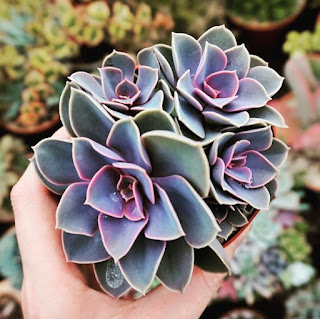A Guide to Keeping Fenestraria Rhopalophylla also known as Baby Toes Healthy: Your Living Stone Companion
Fenestraria Rhopalophylla, commonly known as "Baby Toes" or "Living Stones," is a fascinating and unique succulent that hails from South Africa. With its small, finger-like leaves and mimicry of stones, this plant is a charming addition to any succulent collection. To ensure your Fenestraria Rhopalophylla thrives, follow these friendly and informative guidelines.
If you would like to own one of these amazing plants you can find them here.
Light:
- Natural Sunlight: Place your Fenestraria Rhopalophylla in a bright, sunny spot with indirect sunlight. These plants are adapted to intense sunlight, so they appreciate at least 4-6 hours of sunlight per day.
- Avoid Direct Sun Exposure: While they love sunlight, direct exposure during the hottest part of the day might cause sunburn. Provide filtered sunlight or move them to a shadier spot during peak sunlight hours.
Soil:
- Well-Draining Mix: Use a well-draining succulent or cactus mix. A mixture of potting soil and perlite or coarse sand works well to mimic the natural conditions of their native environment.
- Shallow Container: Plant your Living Stones in a shallow container to accommodate their shallow root system. This helps prevent waterlogged soil and root rot.
Watering:
-Water Sparingly: Fenestraria Rhopalophylla is adapted to arid conditions and prefers infrequent watering. Allow the soil to dry out completely between waterings.
- Be Mindful of Seasons: Adjust the watering frequency based on the season. During the growing season (spring and fall), you can water a bit more often, but in winter, reduce watering significantly as the plant goes through a dormant period.
Temperature:
- Mimic Natural Climate: Maintain a temperature range between 70°F to 90°F (21°C to 32°C) during the day and avoid exposing the plant to temperatures below 50°F (10°C).
- Protect from Frost: Living Stones are not frost-tolerant. If you live in a colder climate, it's best to keep them indoors during the winter months.
Propagation:
- Offsets: Fenestraria Rhopalophylla produces offsets (baby plants) that can be gently separated from the main plant and replanted.
- Leaf Cuttings: You can also propagate from individual leaves, although this method takes longer. Allow cuttings to callus for a day or two before planting in a well-draining mix.
Pest Control:
-Monitor Regularly: Keep an eye out for common succulent pests such as mealybugs and aphids. If detected, treat them promptly with insecticidal soap or neem oil.
- Isolate New Additions: Quarantine new plants for a few weeks to ensure they are pest-free before introducing them to your existing collection.
Seasonal Considerations:
-Summer Dormancy: Living Stones may go through a summer dormancy period where they retract into the soil. Reduce watering during this time and allow the plant to rest.
Enjoy the Unique Beauty:
-
Observe and Appreciate: Fenestraria Rhopalophylla is a captivating plant that showcases its uniqueness through its stone-like appearance. Take the time to observe and appreciate its growth and subtle changes.
By providing the right balance of light, soil, water, and care, your Fenestraria Rhopalophylla will reward you with its charming presence and resilient nature. Happy gardening!

.png)




